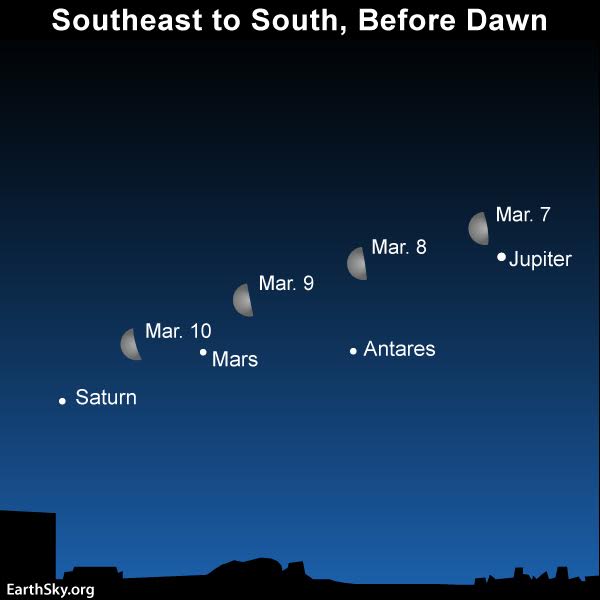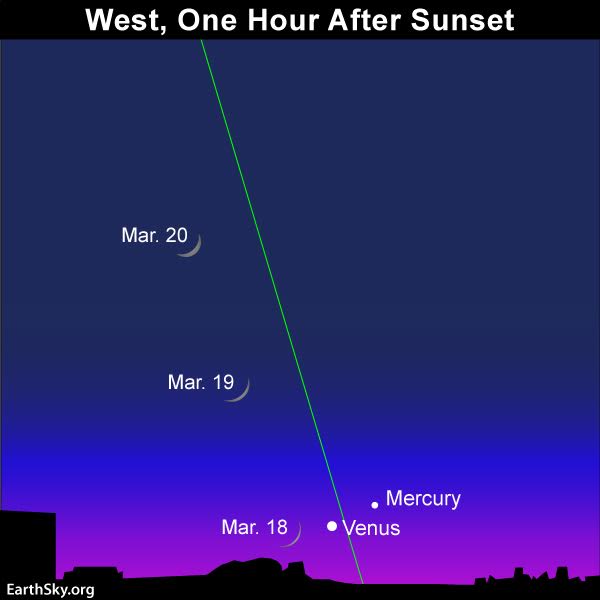
At top: John Ashley of Montana caught multiple planets together in the sky in early 2016. View full image.
Can you see all five bright planets at the same time in March 2018, as we did in early 2016? No. But, especially if you live in the Northern Hemisphere, March 2018 is a great month for catching all five bright planets. If you live in the Southern Hemisphere, you’ll have your best chance to catch the five planets in April 2018. Seek for Mercury and Venus in the west after sunset, and then for Jupiter, Mars and Saturn before dawn.
By bright planet, by the way, we mean any solar system planet that’s easily visible without an optical aid and that’s been watched since time immemorial. In their outward order from the sun, the five bright planets are Mercury, Venus, Mars, Jupiter and Saturn.
What’s fun this month is that the inferior planets – Mercury and Venus, which orbit inside Earth’s orbit around the sun – are located in one part of the sky, the western sky after sunset. Meanwhile, the superior planets – Mars, Jupiter and Saturn, which orbit outside Earth’s orbit around the sun – are best viewed after midnight, or in the predawn hours.
Here’s how to see Mercury and Venus. They’ll be relatively easy to view after sunset at northerly latitudes, but not that easy to see from temperate latitudes in the Southern Hemisphere, where these two worlds set almost immediately after the sun. Look low in the west shortly after the sun goes down. Venus will act as your guide to Mercury, because it’s about 12 times brighter than Mercury now. These two worlds are now very near each other on the sky’s dome. Beginning around March 3, they’ll be only a little more than one degree apart (that’s about the width of your little finger at arm’s length). Venus and Mercury will remain close enough together on the sky’s dome to fit inside a typical binocular field (about 5 degrees) for the first three weeks of March 2018. So if you spot Venus, but not Mercury, aim binoculars at Venus to see both worlds in the same binocular field. Read more about how to spot Venus and Mercury after sunset.
Here’s how to see Mars, Jupiter and Saturn. To see these superior planets, shift your gaze eastward to watch them as they’re ascending into your sky. Jupiter rises first each night, followed by Mars and then Saturn. Why can’t we tell you what time they’ll rise for you? The reason is that they have slightly different rising times as seen from different parts of the globe. But, especially as viewed from northerly latitudes, Jupiter, then Mars, then Saturn all rise quite late at night. As viewed from southerly latitudes on Earth’s globe, Jupiter, then Mars, then Saturn all rise earlier.
Jupiter is very bright. It’s brighter than any object in the sky except for Venus, so you’ll have no trouble spotting it after it ascends over your eastern horizon within an hour or so after midnight (from the northern part of Earth’s globe). Red Mars and golden Saturn are much fainter, and they won’t rise until closer to the dawn.
Click here for recommended sky almanacs; an almanac can give you the setting times of the sun, Mercury and Venus in your sky, and the rising times of Jupiter, Mars and Saturn.


If you’re a complete novice at planet-watching, let the moon assist you. In the course of a single month, the moon passes every visible planet, staying in the vicinity of each planet for a few days of that month. Look for the moon with Jupiter, Mars and Saturn, starting on the morning of March 7, and seek for the moon with Venus and Mercury in the evening sky, starting around March 18 or 19.
By the way … take a good look at the gap on the sky’s dome between Mars and Saturn. It’ll narrow throughout March. A conjunction of Mars and Saturn will take place in early April 2018.
Bottom line: In March 2018, try your luck at catching all five bright planets.











